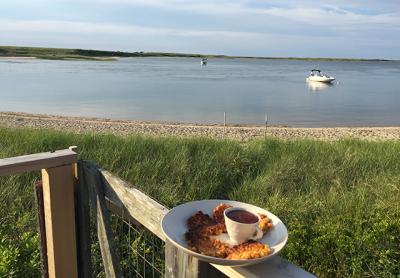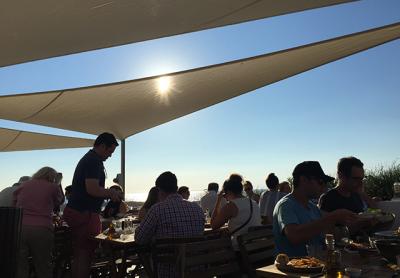Seasons by the Sea: The Upper Crust
Seasons by the Sea: The Upper Crust

Anybody who’s ever made a pie knows they’re not that easy. Making a good piecrust can be a delicate and somewhat complicated process. If you overmix or add too much water, you may end up with a tough one. Even the humidity in the air can wreak havoc with your efforts. Getting the bottom crust to bake thoroughly without burning the rim is nerve-wracking. Choosing what kind of fruit filling can also lead to mistakes: Do you add cornstarch or flour to bind it? How much? You may end up with a runny mess, a glutinous one, or a dry-as-a-bone one. Making a pie takes hours, and when you take into account the cost of good, local fruits and berries, it can also be an expensive endeavor. Is it any wonder then that a favorite shortcut in the summertime is to get a pie at a farm stand or market?
Over the last couple of years I have done random taste tests of fried chicken and pizza by the slice. Since it is impossible (and too expensive) to try every single batch of chicken or pizza slice out here, I scribbled out some names, threw them in a hat, and drew 10. To taste test pies (even more expensive), I used the same process, drawing seven.
Unfortunately, one of the farm stands that was chosen (Round Swamp in East Hampton) could not set aside a pie for me to pick up, and ran out before I could get there. For the record, I already know their pies and baked goods are excellent. The pies there are $29.99 for the large and $14.99 for the small. I was also crestfallen that the Sag Harbor Bakery, Carissa’s, and the Lobster Roll’s pies didn’t make the random cut, but what can you do?
The pies we ended up trying were from Briermere Farms in Riverhead, Tate’s Bake Shop in Southampton, Loaves and Fishes in Sagaponack, Blue Duck (available almost everywhere), Breadzilla in Wainscott, and Balsam Farms in Amagansett. Some of the pies were reheated, some were eaten fresh at room temperature, some were served a la mode with vanilla ice cream. Over a period of a few days we had a number of taste-testers, three of them professional chefs.
I considered limiting the taste test to all blueberry or all peach raspberry, but this was impossible. We tried everything from double-crust apple to streusel crumb-topped sweet-and-sour cherry to mixed berry to the adorable tractor-shaped dough cutout pie of Balsam Farms.
Briermere Farms is a true destination for pie lovers. The storefront is tiny, but the volume produced is staggering and the prices quite reasonable. Right now, Briermere has 33 pies on its summer menu. Most of the fruit used in the pies is grown on the farm and you can buy the pies frozen for future use. Prices range from $17 to $34 with most in the $17 to $19 range.
It is not known what the crust is made with (a wee bit of lard? Margarine?), but it is a superb one, flaky but substantial with a good balance of salt and sugar. The raspberry pie is my favorite in the summer, and I love the apple dumplings in winter. For the record, I have no problem with a bit of lard or shortening in a pie crust. Butter alone gives it flavor but it is difficult to work with. Shortening mixed with butter lightens it and makes it flaky.
The Balsam Farms pie was by far the cutest, the surface adorned with little dough flowers, letters spelling out B-A-L-S-A-M, and a tractor. At a whopping $42 it was the most expensive pie we tasted. The filling, a mixture of raspberries, blackberries, blueberries, and cherries was absolutely delicious and one of our favorites. Unfortunately, the crust was one of our least favorites, lacking salt, sugar, and . . . flavor. It was rolled thin, cooked all the way through, and had a good “short” texture, but sorry guys, this one needs tweaking.
Next stop was Breadzilla, where Nancy Hollister insisted I try the apple pie. F.Y.I., for years Breadzilla made the pies for the Halsey’s Milk Pail and they are excellent, especially the streusel topped ones. The pies at Breadzilla are $25. This apple pie had an excellent and sturdy filling, sweetened just enough, and a crust with the perfect amount of salt and fat.
When I called Sybille Van Kempen at Loaves and Fishes, she agreed to set a pie aside for pickup and even offered to bake one off fresh the next day. Loaves and Fishes pies are all $34. We tried the peach blackberry with a streusel crust, and she told me all pies have an all-butter crust. “We’re European, we don’t use margarine or shortening.” This was absolutely one of the best pies we sampled, from the generous amount of juicy, gingery peaches to the miraculously flaky crust and the oatmeal-laced topping.
At Tate’s Bake Shop in Southampton, most of the pies are $17.95. The raspberry peach had one of the best crusts we tried — short, flaky, and with the perfect amount of salt and sugar. The consistency and flavor of the filling was also excellent.
The Blue Duck Bakery’s sweet and sour cherry crumb-topped pie was the least expensive at $17 and one of the best. The filling had a good blast of tartness from the sour cherries and a good, thick but not gluey, consistency. The bottom crust was flaky and tasty and the streusel topping crunchy.
The final consensus was that the top three pies we tasted were from Loaves and Fishes, Tate’s, and Blue Duck. We also agreed that if the Balsam Farms mixed berry filling could have been baked into any of these other pies’ crusts, it would have made the most perfect, stupendous, splendidly marvelous pie of all.
If you’re up to the task, here are some recipes for you to try at home. Happy baking . . . or buying!
Click for recipes




